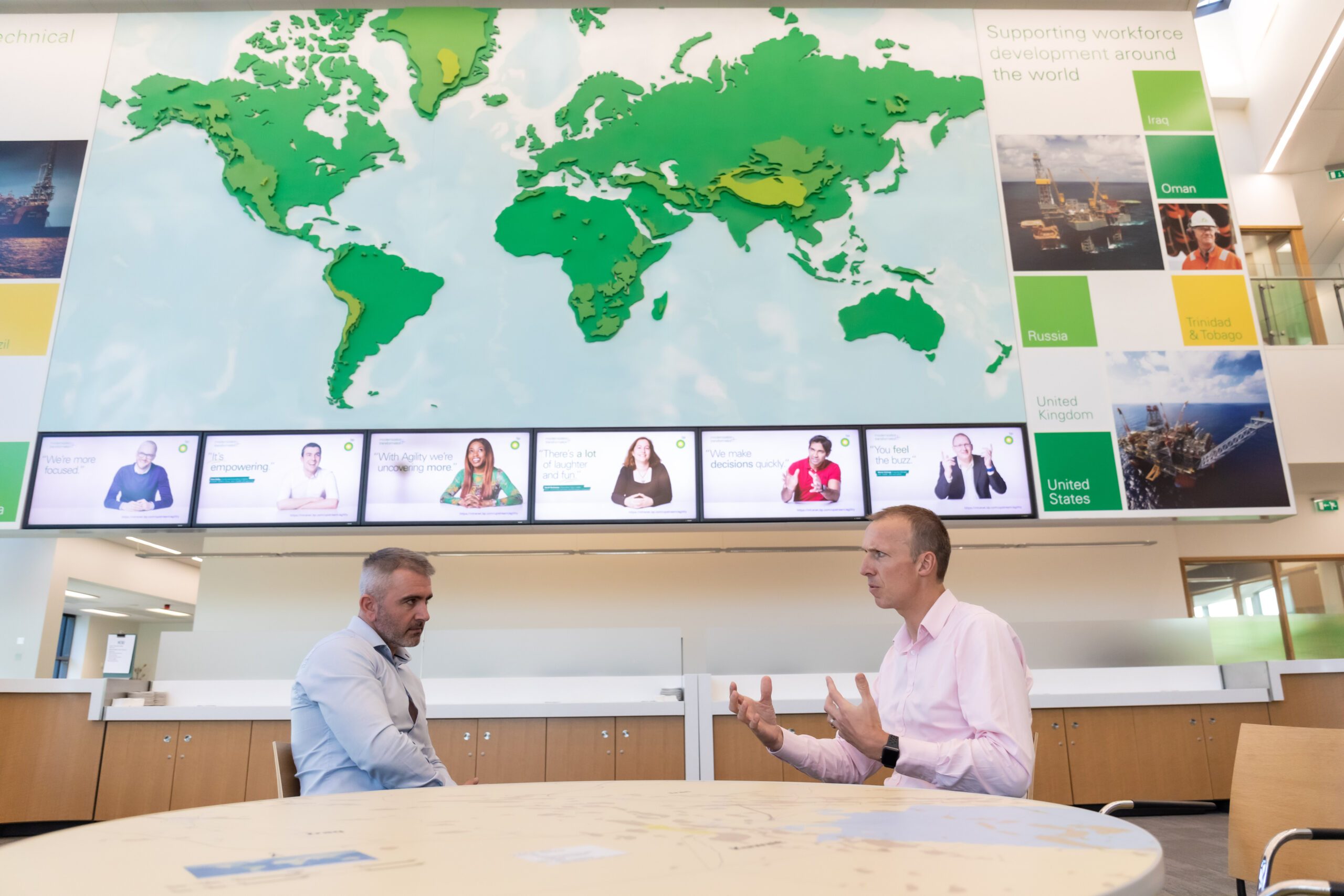As you drive into the BP village in Sunbury you start to get a feel for the scale of the company. Of course, BP is one of the world’s most recognised brands and it goes without saying that most people already know it’s a big business. That magnitude is brought home as you enter the sprawling location that houses its International Centre for Business and Technology. As I drive through the site not only am I considering the vastness of its facility I also ponder how you architect an IT solution for a company of this scale; one that operates in a further 77 countries, employs more than 73,000 people and is in the middle of an energy revolution that is driving fundamental change to its entire business model.
BP is a global powerhouse in the energy sector and is the world’s fifth most valuable energy brand. Its operations stretch from the deep sea to the desert, from rigs to retail, and they deliver energy products and services to people around the world. It provides customers with fuel for transport, energy for heat and light, power for industry, lubricants to keep engines moving and petrochemicals used to make everyday items such as paints, clothes, packaging, and even your mobile phone.
As all enterprises begin to adapt to the brave new world of modern commerce powered by digital transformation and underpinned by the need for purpose and sustainability, BP (and the other energy giants) is grappling with both a shifting technological landscape and root and branch change to the demands and expectations of the energy sector and those who consume its produce.
In early February, newly appointed CEO, Bernard Looney, set out a new low carbon ambition for BP: “To be a net zero company by 2050 or sooner and to help the world get to net zero.”
Looney introduced a package of 10 aims underpinning this ambition which included being net zero on greenhouse gas emissions from BP’s operations and on the carbon in BP’s oil and gas production, both on an absolute basis and both by 2050, or sooner. In addition to these absolute reductions, BP aims to halve the carbon intensity of the products it markets, again by 2050 or sooner.
“We also aim to be net zero on an absolute basis across the carbon content of our upstream oil and gas production. We are aiming to make absolute reductions, to net zero, of around 415 million tonnes of emissions – 55 million from our operations and 360 million from the carbon in our upstream production. That is not far off the total emissions of the UK – the world’s 6th-largest economy and the second biggest national economy so far to set a net zero aim.”
Moving towards a new era for energy
It is estimated that global energy consumption will increase by 30 percent over the next 20 years while the clamour for more sustainable and responsible energy production is finally condensing into a more meaningful narrative. Energy companies, car manufacturers, airlines, retailers, environmentalists and politicians have been talking about the energy crisis for decades; it seems that we are rapidly approaching a point where talk will be replaced by action and the global energy producers are front and centre when it comes to shaping the future of how we power our insatiable need for energy.
BP began evaluating its technology landscape more than a decade ago when cloud technologies were in their infancy and the tide of opinion around climate change and sustainability had only just begun to rise in earnest. Since then the technologies have matured and the trickle of meaningful action on climate change and energy consumption has burgeoned into a tidal wave of activity. New thinking and an urgent need to address carbon emissions demands significant re-evaluation of business practices in order to remain competitive and to live-up to the expectations of an increasingly exacting population.
So what is driving change at BP? Is it the challenge of meeting the increasing demand from consumers, along with the need for cleaner and more sustainable energy? Or is it the emergence of new technology that is offering up improved and more efficient ways to extract, refine, market and sell its products?
According to Stewart Fry, global vice president for IT&S, new and emerging digital technology is one of the key drivers that will enable BP to deliver its net zero ambition: “BP has been active in advancing the energy transition for many years – by reducing emissions from our operations, improving our products and investing in low carbon businesses. We agree the world is not on a sustainable path and there needs to be a rapid transition to a low carbon future.
“It’s very exciting to introduce BP’s new ambition, which builds on much of what the company has already been doing.
“Digital technology has unleashed huge potential and is allowing us to address the three things that are fundamental to our business. The first one is how do you deal with emissions and become more productive? How do you do the same thing only cleaner, cheaper and more efficiently? Technology is absolutely at the heart of that.
“The second one is how do you improve your products? How do you extract gas without the need to do lots of new projects which in themselves require steelwork, lots of concrete, and are high in carbon emissions through their creation.
“And thirdly is the creation of new businesses and opportunities. BP owns the biggest EV charging company in the UK, BP Chargemaster, and we’ve just partnered with Didi, a transport platform in China – the world’s largest market for electric vehicles – to provide EV charging. In December last year, we completed our joint venture with Bunge in Brazil – a leader in agriculture, food and ingredients – that will create a bio-energy company in one of the world’s largest fast-growing markets for biofuels.
“We also see solar as having huge potential and by 2040 it could generate 12 percent of total global power based on recent trends or as much as 21 percent in a scenario consistent with the Paris climate goals. We have a 50 percent share in Lightsource BP, one of Europe’s leading developers of solar projects which is rapidly expanding its global presence.”
Global energy businesses usually have two key operations; upstream and downstream. The upstream business (sometimes referred to as exploration) is everything that the company does to find and produce raw materials such as crude oil and gas. The downstream business includes the refineries, plants, and retail outlets that ultimately process and deliver the products and services.
At BP, the upstream or exploration function has been responsible for renewing BP’s resource base through access, exploration and appraisal, while the reservoir development function is responsible for the stewardship of the resource portfolio over the life of each field. The global wells organisation and the global projects organisation are responsible for the safe, reliable and compliant execution of wells (drilling) and major projects. And the global operations organisation is responsible for operations such as midstream transportation and processing activities.
The downstream business together with global oil supply and trading activities, has made up BP’s integrated fuels value chains (FVCs). BP sells refined petroleum products including gasoline, diesel and aviation fuel, and has a significant presence in the convenience retail sector and a growing presence in the advanced mobility and low carbon sectors. It also manufactures and markets lubricants and related products and services to the automotive, industrial, marine and energy markets globally. These products are produced using industry-leading proprietary BP technology, and are then used by others to make essential consumer products such as food packaging, textiles and building materials. The petrochemicals business alone operates 16 separate manufacturing facilities in ten countries.
However, along with the launch of its ambition, BP has also announced plans to retire these divisions, undertaking probably the most far-reaching reorganisation in its history, with the intention of becoming a more integrated, more focussed company to deliver on its aims.
BP is a long-time customer of SAP and its operations are intrinsically linked to SAP technology in both its upstream and downstream businesses utilising ECC as its core ERP product. It also takes advantage of SAP’s acquired platforms such as Ariba (procurement), Concur (expenses) and some Fieldglass (workforce management).
Jens Amail, UK&I managing director at SAP, said: “SAP is delighted to be the global technology partner for this energy powerhouse and we look forward to continuing our support for BP as it transitions to the next stage in its business growth. SAP’s Intelligent Enterprise is at the heart of BP’s efforts to tackle the world’s energy demands and its move towards cleaner and more sustainable energy production.”
BP also has an array of other systems and niche solutions which sit outside of the core SAP landscape and power business units such as the lubricants operation which runs some JD Edwards and its own proprietary system called ISP. In addition, there are other niche parts of the business which remain on very old platforms such as the lubricants operation in Greece which is still running SAP 4.0B – a solution that is more than 20 years old but, according to BP, runs like clockwork, costs peanuts to maintain and is doing everything they need it to.
The legacy landscape
The global footprint is complex and back in 2010 there were more than 90 separate instances of SAP ERP, BW, SCM and other applications stacks deployed around the globe. In order to meet the challenges of a rapidly evolving energy market BP has embarked on a journey of rationalisation and digitalisation in order to reduce its footprint, become more efficient, identify new opportunities and transition towards cleaner and more sustainable energy production.
“We’re simplifying and modernising our enterprise activities. This means we can be much more flexible in supporting the business, and bring new, lower carbon activities on-line quickly, as well as develop innovative digital solutions,” said Fry.
The target landscape is still a heterogeneous mix of nearly 40 different instances but the deployments of ECC have dropped from 31 to 20 with a rationalisation of BW from 23 to 15 and the migration of 75 percent of all workloads to AWS has already been completed. BP is also integrating S/4 and HANA into its business although these are baby-steps for now and full-scale adoption of SAP’s flagship product is some way off – and probably much further in the future than SAP would like despite the recent news on extended life for Business Suite 7.
BP works with SAP, Accenture, IBM, Wipro and SNP on its many and varied projects with the latter most notably involved with several POC projects to further assess the migration path to S/4.
Ben McGrail, managing director at SNP, said: “We were delighted that BP chose SNP to help automate and accelerate its SAP transformation programme as part of its Modernise IT agenda. Together we have built up a track record of success including projects to carve out, merge and upgrade SAP systems along with software-led S/4HANA assessments and proofs of concept.”
As it stands today, BP has one S/4 HANA instance live since 2018 primarily running MDG, and is currently carving out its EHSM system into its own S/4 HANA instance with the help of SAP. The refineries business in Europe is also starting to transition to S/4HANA where it will be able to take advantage of significantly improved reporting and analytics coupled with real-time data to support mission critical decisions. However, despite several other S/4 exploration exercises in the wider business, BP will retain ECC as its core ERP platform for the time being.
Ian Stubbings, engineering lead at BP, said: “We’ve been looking at S/4 HANA since 2014 and we have run various proof of concepts with mixed results. At the moment, EHSM and the refineries are transitioning to S/4 and we will continue to evaluate all options as the technology matures and our business demands change. One of the major drivers for moving EHSM is the reporting capability of S/4 which delivers real-time analytics and that is a big change from having to pump everything into BW and getting data from yesterday.”
Asked why BP’s plans don’t currently include a full-scale transition to S/4, Stubbings said: “Like a lot of SAP customers, over the past decades we built our own functionality on top of the standard SAP solution, and will need to retain a lot of this in S/4. The scale of the task means this will not be an easy transition and requires careful planning to ensure the new S/4 HANA based landscape will meet current and future requirements with the right mix of flexibility, agility and cost. Consolidation is no longer the key driver it once was, with some systems already being migrated to S/4 to pave the way. However, there will be options to move systems to new templates as the new landscape evolves.”
Migrating workloads to the cloud
Like most enterprises, BP also considered its infrastructure options, as a maturing proposition from the hyperscalers means the value, flexibility and reliability of enterprise-grade cloud hosting outweighs the incumbent cost and value of retaining physical servers.
BP’s Information & Technology Services (IT&S) organization manages many SAP applications used by thousands of employees globally. These applications are essential to the company’s day-to-day supply chain, order to cash, procurement, and finance activities.
BP initially started the cloud journey for SAP workloads by implementing an SAP HANA–based ‘agile analytics’ reporting and insights system in AWS. BP uses the solution to deliver analytical dashboards to executives and provide financial data to the BP finance organisation. It was the success of that implementation that led to BP moving its first production ECC to AWS back in 2017. The solution utilises Amazon Elastic Compute Cloud (Amazon EC2) R4 instances. The R4 instances are memory-optimised instances that can run large in-memory applications.
However, as digital technology opened up new opportunities, BP needed to be able to respond very quickly. “We made a strategic decision to adopt a company-wide, cloud-first approach, so we could be more agile and flexible, as well as improve operational efficiencies,” explained Fry. “This includes shutting down all on-premise mega data centres, and accelerating our digital ambition through workplace, network and cloud transformation programmes.”
BP is now moving its entire SAP landscape to the cloud to take advantage of the agility, flexibility and performance stability it offers. Currently 75 percent of the workloads are running on AWS with a plan to migrate the remaining instances shortly. In just one operating unit (the Castrol business), BP historically maintained 11 physical servers, including database and application servers, to support the production instance and those servers can now be decommissioned. In addition, the system was under-utilised when it was hosted in the on-premise data centre. On AWS, BP only pays for what it uses and can flex the system size according to processing needs, which helps control costs much more efficiently. Moving to AWS has also increased the performance of the ERP systems, and in terms of average response times, they are running around 40 percent faster on the AWS Cloud.
As BP continues to focus on simplifying and modernising its activities, the IT&S function has needed to make a step change in agility and flexibility to support business initiatives. “Exiting our European data centres and migrating to AWS supports our digital transformation agenda, and we’re excited about the possibilities for increased flexibility, operational efficiencies, and opportunities to innovate while helping to advance the energy transition,” said Steve Fortune, BP CIO. “We knew we needed to consider options that would give us more flexibility and allow us to be more responsive. Our strategy has evolved. We need the agility to be competitive when prices, policy, technology and customer preferences are changing – and that’s what we get with AWS”.
The two European mega data centres, the largest that BP operates globally, host data from across all BP’s businesses. Moving to AWS enables BP to use a broad and deep portfolio of cloud services, including machine learning, analytics, storage, security, databases, and compute to gain greater insights and automate processes.
“We are pleased to expand our relationship with BP as the company moves its largest mega data centres, which host mission-critical data applications, to AWS,” said Bill Vass, VP technology, storage, automation, and management at AWS. “AWS is the world’s leading cloud, with an unmatched portfolio of cloud services, proven performance, and operational expertise, which is why global companies like BP trust AWS to support their digital transformations.”
Dual challenge of increased demand and carbon neutrality
Going back to my original question; what is driving change at BP? Is technology disrupting the energy sector or is it a sector being disrupted by the environment? The obvious conclusion is that it’s both. BP is more agile, more efficient and more responsive with a decreased footprint, increased SaaS capability, hosted infrastructure and an array of digital tech that delivers richer experiences for customers, employees and partners. But BP’s investment in technology goes far beyond just trying to remain competitive and boost employee engagement.
There is a deep commitment to tackle carbon emissions and technology is playing its role in enabling BP to produce energy more efficiently and sustainably. But technology on its own isn’t going to win the battle and BP along with the other energy providers are fostering new business models to remain competitive and responsible. The UK government’s recent announcement that the internal combustion engine will be eradicated from all new cars by 2035 (five years sooner than the original proposal) is further indication that whilst the energy needs of the world are set to increase, the demand and toleration of fossil fuels is on the slide.
Combatting this dichotomy is the key challenge facing BP and Fry was keen to summarise by setting out the factors that are driving increased demand and the challenges of meeting environmental targets.
“The world is likely to need 30 percent more energy by 2040. That’s being driven by three things. Firstly, there are still over 800 million people in the world with no access to any electricity. Secondly, the work we’ve done at BP suggests that 80 percent of the world’s population today live in countries where energy consumption is so low, that increases in energy tend to go hand-in-hand with significant improvements in human development And finally, it’s simply about overall growth in population.
“All these factors combined drive the increase in demand we are expecting. That increase in energy consumption has to be balanced and offset by a significant reduction in global carbon emissions and BP believes that a rapid transition is needed.
“At BP that’s what we are focussed on. We have now outlined our new ambition to become a net zero company by 2050, or sooner, and to help the world get to net zero. We will be using the huge potential that digital and advanced technologies offer to help us achieve that ambition.”




